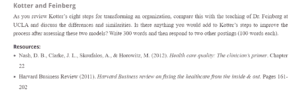Kotter and Feinberg
The eight steps by Kotter include (Nash et al., 2012):
- Create Urgency. Feinberg also created urgency after interviewing patients and realizing that two out of these patients would not recommend UCLA to a friend. Feinberg convened a meeting with the heads of departments after this discovery. He made his findings known and told them it was time for a change.
- Form a Powerful Coalition: Feinberg convinced the department heads that change was necessary; after one of the chairs had an exceptional experience at the New York Presbyterian Hospital, the team bought into the idea of making changes.
- Create a Vision for Change: Feinberg clarified that patient satisfaction was the key driver of change and that care should ensure patients receive the best care. He changed the mission statement to healing humankind one patient at a time by alleviating suffering, promoting health, and delivering acts of kindness.
- Communicate the Vision: The CEO communicated the vision to the change team, and all the staff at the hospital was also aware of the same.
- Remove Obstacles: This was not mentioned in the change plan. The process mainly focused on the positives; the patient was at the center of change. Throughout the change process, the CEO was and continues to visit patients to ensure their satisfaction.
- Create Short-Term Wins: This too was not mentioned. The goal remained to ensure that UCLA lived and surpassed its patient care expectations.
- Build on the Change: Feinberg has initiated other aspects of care that reinforce patient care, including introducing the Talent plus HR tool that further ensures that the employees recruited at the healthcare facilities meet other criteria that go beyond the expected standards. The additional measures are to ensure that the employees have traits that align with the organization’s mission, such as being service minded.
- Anchor the Changes in Corporate Culture: Employees are monitored after recruitment to ensure they deliver service per the healthcare facility’s mission and standards. All employees are part of and work in line with the task. For example, all employees are expected to adhere to procedures like introducing themselves, asking for permission before they touch or examine a patient, explaining what is going on, and personalizing care.
Are you interested in obtaining an initial “Kotter and Feinberg” copy? Connect with us
The changes made at UCLA are awe-inspiring (Feinberg, 2011). Kotter’s eight steps for transformation should add some of the ideas that Feinberg implemented. The first of these steps should include separating services or functions within an organization to maximize resources and improve customer satisfaction. The first thing that UCLA did was to convert a conference room into a quick-service stop where patients that did not need beds were catered for fast, from a 9-10 hour waiting period to a record 90 minutes service delivery period. So while making changes, an organization should first implement, with immediate urgency, a change that will meet the needs of the customer and employees. Another step that should be included is learning from other successful players in the industry. Feinberg took the change leaders to the Presbyterian Hospital to observe how they cared for their patients, took some lessons from the facility, improved the tasks, and implemented them at UCLA. Thirdly, success and failures should be discussed openly and freely. Every meeting at UCLA starts with a narrative from the patients made by the care team. These narratives help in bringing to focus the needs of the patients and the goals/failures that have been met, including ways in which improvements can be or have been made. Lastly, change should involve the customer as a stakeholder and the senior leadership as the continuous drivers of change. The CEO and other department heads have structured visits to patients daily. The patient visits aim to ensure that patient satisfaction is at the 99 percentile at all times. Patients give their views on the care they receive and on the acts of kindness as well as personalization of the care they receive, and this is a way of ensuring that the facility keeps track of the patients. They are likely to recommend the facility to others.
Other Related Post: Exemption of Quality Improvement Initiatives
References
Feinberg (2011). TED x UCLA – David Feinberg – One patient at a Time.mov https://www.youtube.com/watch?v=cZ5u7p-ZNuE
Nash, D. B., Clarke, J. L., Skoufalos, A., & Horowitz, M. (2012). Health care quality: The clinician’s primer
ORDER A PLAGIARISM-FREE PAPER HERE
We’ll write everything from scratch
Question
Kotter and Feinberg
As you review Kotter’s eight steps for transforming an organization, compare this with the teaching of Dr. Feinberg at UCLA and discuss the differences and similarities.

Kotter and FeinbergDo you add anything steps to improve the process after assessing these two models? Write 300 words and then respond to two other postings (100 words each).
Resources:
- Nash, D. B., Clarke, J. L., Skoufalos, A., & Horowitz, M. (2012). Health care quality: The clinician’s primer. Chapter 22
- Harvard Business Review (2011). Harvard Business review on fixing the healthcare from the inside & out. Pages 161- 202
U-Tube Video site:
Client’s Notes:
I need help writing a discussion post for my Quality and Performance class. Please watch the U-tube video about Dr. Feinberg at UCL. Kotter’s eight steps for transforming an organization should be in the thtextbookok reading. Thank you.


